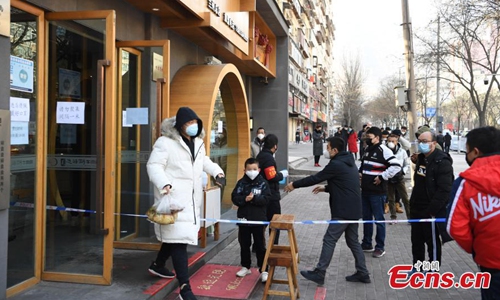HOME >> CHINA,SPECIAL-COVERAGE
Infection clusters loophole exposed
By Chen Qingqing Source:Global Times Published: 2020/2/21 20:38:40
COVID-19 outbreaks in prisons, hospitals, factories pose new threat

Customers eat noodles in a restaurant in Lanzhou, Northwest China's Gansu province. To curb the spread of coronavirus,noodle restaurants of the city are called to limit number of customers and provide scattered tables for eaters. (Photo: China News Service/Yang Yanmin)
The National Health Commission announced that new confirmed infections reached 889 on Thursday, and regions outside Central China's Hubei Province, the outbreak epicenter, recorded 258 new cases, compared with 56 new cases reported the previous day. The daily surge outside Hubei also ended consecutive declines in new infections reported daily for 15 days since February 3.
The sudden increase in new cases was mainly due to new outbreaks in five prisons in Shandong, Zhejiang and Hubei provinces. Shandong reported 202 new cases, 200 of which came from Rencheng prison in Jining while Zhejiang had 28 new cases including 27 from the Shilifeng prison located about 30 kilometers from the city of Quzhou.
New cases in these two provinces accounted for 89 percent of the total, sparking concerns over transmission of the virus rising with cluster cases.
Hubei also revised its morning report on Friday by upgrading its new infection data from 411 to 631, adding 220 new infections in its prisons.
The Hubei health authorities noted that it received a handwritten report from the prison department Thursday night as there was no internet-based data reporting system from the prison system in Hubei. After careful verification, the commission added those cases to the overall data.
In Hubei, 230 infection cases in Wuhan Women's Prison and 41 in Hanjin prison in Jinzhou have been reported,according to the local health authority. No deaths were reported.
Two customers walk out of a shopping mall in Nanjing, East China's Jiangsu Province on Wednesday. Many local shopping areas resumed operation after meeting virus prevention standards set by the city government based on the progress in curbing the epidemic. Photo: cnsphotos

Customers wait outside a noodle restaurant in Lanzhou, Northwest China's Gansu province. To curb the spread of coronavirus,noodle restaurants of the city are called to limit number of customers and provide scattered tables for eaters. (Photo: China News Service/Yang Yanmin)
Full-scale probe
The outbreaks in prisons sent a fresh warning to China despite positive signs in the past two weeks. Those infections occurred in relatively isolated and clean environments, showing that people cannot relax their vigilance in epidemic control work, medical experts said.
At least 11 officials were deposed on Friday in the three provinces as they failed to fulfill their duties to control outbreaks in prisons.
Eight officials in Shandong, including the Party chief of the Shandong Provincial Department of Justice and Party chief of provincial prison management department, were removed from post.
The Central Political and Legal Affairs Commission of the Communist Party of China has formed an investigation team, including officials from the Supreme People's Procuratorate, Ministry of Public Security, and Ministry of Justice, to launch a full-scale probe into the outbreak in the Shandong prison.
Meanwhile, two prison officials in Zhejiang Province have been removed from their posts, and one police officer was under investigation. The director of Wuhan Women's Prison in Hubei was also removed.
The outbreaks were mainly due to the lack of strict management measures, a medical expert who preferred not to be named told the Global Times on Friday. "Don't think that they [prisoners] have no connection with the outside world. The virus could still be transmitted in some places that are relatively isolated," he said.
In addition to prisons, places such as senior homes, welfare homes for children and mental health hospitals usually have relatively high population densities but lack quality medical supplies, and have become vulnerable to the COVID-19 spread.
"With insufficient awareness of enhanced protection, clusters of infection cases [in those places] are also very likely," Yang Zhanqiu, deputy director of the pathogen biology department at Wuhan University, told the Global Times on Friday.
A prison officer in Shilifeng prison had been to the epicenter Wuhan from January 14 to 19, but he intentionally hid his travel history and went back to work until he was diagnosed with COVID-19 on January 29, media reports said.
It also reminds us to pay attention to not only transmission routes via respiratory droplets but also the flow of infectious sources, Wang Lixiang, director of the emergency medical center of the General Hospital of Chinese People's Armed Police Forces, told the Global Times on Friday.
"Especially in places such as prisons, we must make great efforts to screen suspected infections and not to ignore any of them," he said.
However, there is no need to overreact to some clusters of infections, as it's impossible to be flawless in epidemic control work. "Containing the epidemic spread can't only depend on medical measures and treatment. It requires people's understanding of the disease and their health habits," Wang said.
High alert
Recent clusters of infections in places such as hospitals, office buildings and factories sparked new fears, while some regions strive to resume work after the outbreak practically shut down factories and caused pain for the world's factory and global supply chain.
A factory with more than 400 employees which manufactures titanium dioxide in Southwest China's Chongqing Municipality was forced to shut down after a cluster infection, with three people confirmed infected with COVID-19 and over 100 employees sent to quarantine, media reported.
A central Beijing hospital reported 36 cases as of Thursday, a sharp increase from nine cases from two weeks earlier, leading many to fear a potential surge in infection numbers in the capital.
More suspected cases also emerged in a senior home in Wuhan, as the elderly have weaker resistance and poor self-care ability, and cross-infection also occurred among medical staff and seniors.
Given the current situation, resuming work while continuing to curb the virus is a highly challenging task for China, Zhang Yiwu, a professor at Peking University, told the Global Times.
"For places with large-scale gatherings or with high population densities, we must admit that epidemic prevention and control work remains difficult while being highly alert," he said.
"Whether we adopt more flexible measures, or one policy for one place, we have to take those risks into account," he said.
RELATED ARTICLES:
Posted in: SOCIETY,FOCUS